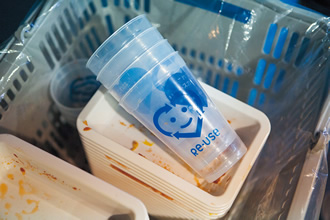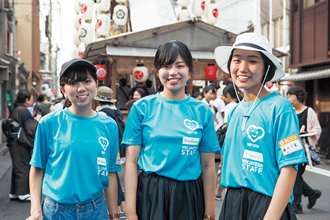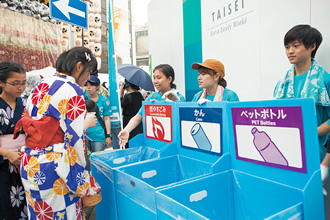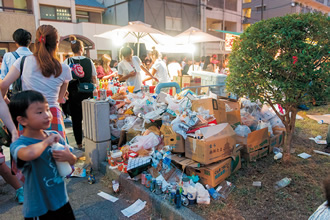niponica is a web magazine that introduces modern Japan to people all over the world.
2018 NO.24
Japanese Festivals Throughout the Year

Supporting Festival Excitement
“Zero Garbage Action Plan” Spreads from Kyoto
Collaboration: Gion Festival Action Plan for Zero Garbage Association
The Gion Festival in Kyoto goes back 1,100 years. Fantastic floats take to the streets, and around 600,000 people from all over Japan are there to see them. But the event generates almost 50 tons of garbage, some of which gets left on the streets.
The Gion Festival Action Plan for Zero Garbage Association was established in 2014, aiming to be part of the solution by boosting eco-awareness. To reduce the number of food and beverage containers thrown away, the association launched a program to lend and collect reusable ones during the festival period, and to set up “Eco Stations” to separate recyclables from solid waste. With more than 2,000 volunteers in action, the festival in 2014 generated 25% less waste than the previous year, even though visitor numbers were up 24%! In 2017, with corporate support, the program set out to further increase recycling rates by affixing “Reuse me!” icons to containers. Results were good.
The program was spearheaded by a non-profit group called Environment Design Laboratory, ecotone. Its director, Ota Kohei, explains: “When spectators bring back the containers for recycling, they’re likely to say things like ‘I enjoyed the food’ and ‘Hey, thanks a lot.’ We didn’t hear that much before, when the containers were throwaways.”
Many of the volunteers are young and sign up year after year. They say that the Action Plan is having more impact every year. It seems that festivals help promote public eco-awareness.
The Action Plan in Kyoto is attracting attention in other cities, too. Organizers of the Tenjin Festival in neighboring Osaka Prefecture have begun setting up “Tenjin Festival Action Plan for Zero Garbage” groups in some localities, using Gion Festival strategies. People from other parts of the country visit to study the program. The Action Plan has the dynamism it needs to expand from Kyoto nationwide.
Recycle stations were set up in about 50 locations, for separating into combustibles, cans and plastic bottles.
The Tenjin Festival used to generate around 60 tons of combustible garbage, but this was cut in half in the first year.










